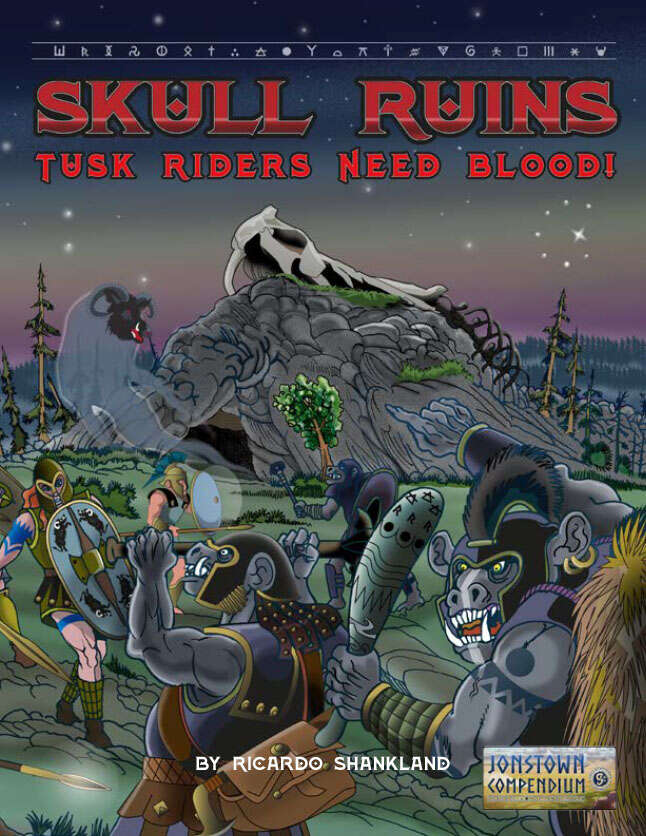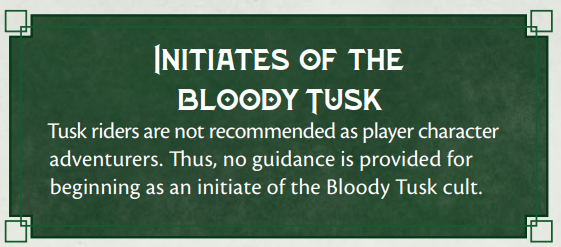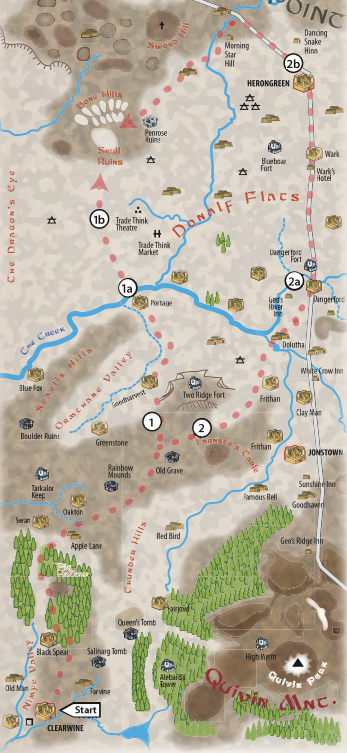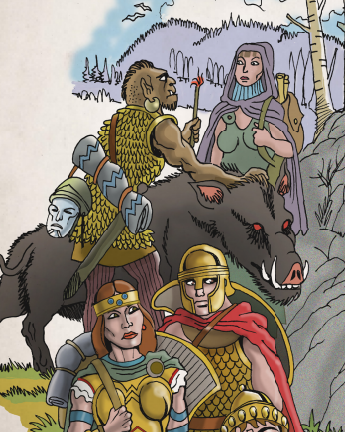The enemy of my enemy is my friend—but do you really believe that? Can an alliance of convenience last? Skull Ruins: Tusk Riders Need Blood!—Ricardo Shankland’s debut RuneQuest (RQG)adventure for the Jonstown Compendium—explores that theme.
Queen Leika tasks the adventurers with escorting the tusk rider defector Penjurlhi to the Skull Ruins so that he can perform a ritual to reinforce the bond with his tusker, the giant boars which give tusk riders their name. The work explores the relationship between tusk riders and their boars, a new adventure site, and aspects of tusk rider culture in Dragon Pass.
Let’s dive on in!
Disclaimers: This review contains some plot spoilers for the adventure. I have a working relationship with the author’s relatives on an unpublished project. The author is not involved in that project, and I did not work on Skull Ruins.

What’s Inside?
Skull Ruin is basically divided into two sections: the 50-page adventure “Tusk Riders Need Blood!” and a 20-page collection of appendices presenting variants on tusk rider culture. While the sections share common themes, overall my experience was that they’re largely separate from one another. For example, I wouldn’t feel obligated to reference the appendices while running the adventure.
“Tusk Riders Need Blood!” begins with an escort mission combined with an intriguing character conflict: how do the adventurers feel about working with a tusk rider? For those who don’t know, this non-human species is pretty much the only non-Chaotic species described in the Glorantha Bestiary as wholly and unrepentingly evil.

I certainly enjoy providing evil antagonists for heroic adventurers to clobber. Yet it’s not particularly on-theme with Glorantha as a setting considering the vibrant imagination put into trolls, ducks, and so on. Broos are excellently repugnant for dungeon fodder. We can seek more complex evils from the non-Chaotics.
Yet “Tusk Riders Need Blood!” does not assume Penjurlhi is the “one good tusk rider.” He’s not an especially nice person, but he’s not a caricature like Drizzt Do’Urden. Penjurlhi is loyal, generally honest, and generally selfish. His love for his mount is sincere, yet he’s also quite callous. For example, he’s perfectly willing to let the adventurers kill other tusk riders (or to murder captive riders in their sleep himself) to reach the Skull Ruins and complete the Appease Earth ritual.
The journey’s description is simple and effective. A declining rating for the tusker’s mood provides urgency and structure, while the players are given meaningful ways to help Penjurlhi handle the beast. The reward for all this trouble is Penjurlhi’s continued cooperation with the Colymar Tribe to reveal raid patterns, hidden paths, and other secrets of the tusk riders. The journey provides roleplay opportunities for the adventurers to decide if they trust their ward before serious conflict hits.

The Skull Ruins are the skeleton of a True Dragon which lays in the heart of the Dragonewt Wilds. An Orlanthi bandit lord named Gornorix uses the ruins as his hideout. From there he has raided Lunars, Sartarites, and traveling caravans indiscriminately. Although he began during the Lunar Occupation, Gornorix is an outlaw, not a patriot. His pet Earth Witch has learned to cast Appease Earth through her own methods, allowing Gornorix to build relationships with tusk riders and their associates. According to their instructions, the adventurers are to bring Penjurlhi here so the Earth Witch can perform the ritual and they can all go home.
Of course, adventures rarely go according to plan.
During the journey, the adventurers may have encountered a Mistress Race troll lordling whose cousin was captured by Gornorix (depends on their route). This cousin will be sacrificed in the Appease Earth ritual. The trolls want to attack the Skull Ruins and free the cousin. They may ask the adventurers for aid.
This sets up a complex and fascinating set of possibilities in which the adventurers might be attacking the dungeon, defending it, neutral, or switching sides. There are strong motives and reasons provided for why the adventurers might make each choice, and contingencies for surprises in almost all of the plausible avenues. Despite the compelling stories told by the various non-player characters, the adventurers remain at the story’s center. Their choices determine the outcome.
The appendices describe a bit of tusk rider lore—introducing the human Boarsbeard Clan descended from Bloody Tusk converts—but largely focus on the new Cult of Sawtooth. This intriguing cult worships a carnivore Aldryami’s ghost on the verge of Herodom. Sawtooth is a great example of the description that Heroes are “endowed with exceptional powers and uses those gifts to battle against enemies that endanger the peace and well-being of the community. And yet, the Hero is not bound by the rules and restrictions of the civilization they defend …” (RQG page 10). Sawtooth sought new ways of living for the good of the forest, and consequently is an outcast and heretic.
The cult’s primary worshipers are tusk riders, outcast Aldryami, and the occasional outcast troll. Sawtooth provides rare magics useful for tusk rider scouts, and offers a special form of Resurrect which certainly could tempt adventurers to risk visiting his temple in the Stinking Forest. His cult is fully described with the Hero-ghost himself, a dryad priestess, and a mysterious hermit statted out for the gamemaster’s use.
As you may have concluded from describing these two sections, the halves of Skull Ruins are connected thematically but not directly. The adventure includes a few initiates of Sawtooth in a journey encounter, but otherwise the adventure doesn’t really explore tusk rider culture as much as I had anticipated. My expectations were something along the lines of “Skyfall Lake” in Trollpak (albeit with lots more violence), an adventure which focused on the players encountering tusk riders and deciding how to handle the situation. The adventurers do get to know Penjurlhi in “Tusk Riders Need Blood!” but overall I felt the adventure focuses on their role in the conflict between the Orlanthi bandits and the troll raiders.
Speaking of, I do truly love Gornorix. He’s super Orlanthi, and also just such a jerk. Throughout, Shankland’s characterization is quite strong. The troll lordling and the Earth Witch are both memorable. I felt not just that I understood how the non-player characters think, but also how to present them at the table. This is supported by good “high-level” organization of the adventure material into coherent sections with clear directions. Shankland’s execution of this complex situation is well done.
In addition to the odd lack of tusk riders in the adventure, it also struck me as odd that the adventure lacked dragonewts. After all, the Skull Ruins are a dragon’s skull in the Dragonewt Wilds. It felt strange that Gornorix had managed to lurk there for years without reprisal. I kept seeking an explanation, but one was never forthcoming. Despite liking the troll non-player characters and plot elements, it makes more sense to me that dragonewts would be trying to drive the Orlanthi out.
Production
Skull Ruins is a collaboration between Ricardo Shankland and long-time Glorantha creator and artist Dario Corallo. Shankland did the words, while Corallo did the art and graphic design.
Overall, I’d describe the text’s polish as pretty much right on my subjective “indie average.” It’s clear to me that the author put in legwork hunting typos and other infelicities, but they do still appear on occasion. I do also feel that Skull Ruins would benefit from a line edit. In particular, I advise the author to keep an eye out for overuse of commas to create extended phrases. The text doesn’t quite hit “run-on sentences” to my eye, but a line edit focusing on sentence construction could improve the “ground-level” clarity.
There’s also a few odd word usages which I’m not used to seeing, such as “the Colymars.” However, these are consistent throughout the work and thus are a stylistic choice, not an error.
For visual design, the graphic design works well and the illustrations are excellent. There were a few unusual choices in the layout of the text which I feel are opportunities for improvement. In particular, the indentation of the first line of paragraphs is too consistent. For example, there are instances where a paragraph continues from the left column to the right, and the first line of the same paragraph is indented in the right column. Another odd example is the lack of indentation in statblocks. The hanging indent which is standard in the Jonstown Compendium template improves readability, especially when an ability’s description requires multiple paragraphs and there’s no boldface header to break up the text.
The art, though. This book might be my favorite Corallo has worked on. (At least of those I’m familiar with—I don’t know all of his Gloranthan work.)
What really captures this art’s success is its strong use of Gloranthan themes in combination with frequent portrayals of RQG‘s pre-generated adventurers, Vasana & Co. Being able to see the pre-gens engaging throughout the adventure helped bring the story to life.

Further, all of the major non-player characters are illustrated throughout Skull Ruins. This wealth of illustration strengthens the adventure’s appeal and keeps the book firmly grounded in what the players are experiencing. I can see myself using almost all of the art as examples to players.

Still hungry for more Gloranthan adventures? Check out my To Hunt a God, also available on the Jonstown Compendium. It’s a crazy heroquest into a magical elf wood to perform divine euthanasia for a half-mad god! I love it dearly and hope it’ll bring as many shenanigans to your table as it has mine.
Conclusion
Skull Ruins contains an excellent adventure and intriguing appendices about tusk rider-adjacent lifeways. Even if these sections could be more strongly connected, I like both quite a lot. By way of advice to the creators, my instinct is that releasing the adventure alone at a lower price point would be more successful. The Cult of Sawtooth definitely deserves to be out in public! But it might have fit better into a different product.
That said, overall I do recommend Skull Ruins: Tusk Riders Need Blood! and I do think it’s worth the price point ($17.95). The book’s stuffed to the brim with interesting ideas and Gloranthan goodness. There are some oversights and flaws, as I’ve pointed out, but the good vastly outweighs the bad on my scales.
I’m giving this a full five because this is the author’s debut release. This is not merely “playing nice” or “overlooking errors.” (I’m well-aware I’m fussy about textual polish and it’s significant in my overall opinions.) Shankland’s work deserves a five because of the excellent creativity and organization of the adventure. That’s damn hard to pull off. Having a fun and creative adventure concept is one thing, but executing it well is another. The adventure’s combination of player-centric narrative choices and comprehensible semi-linear structure leaves a lot to admire. This is something I’m actively interested in shoehorning into my current campaign.
As a last thought, a quick note on non-player character statistics—this adventure’s antagonists are tough. Even the routine antagonists have a good bit of magic and are provided with nasty tactics and clever leadership. This tactical support is also a reason I like the adventure, but I do encourage prospective gamemasters to read the statblocks carefully. I can see this adventure killing an entire group of newer adventurers unintentionally. (I can also see it killing experience adventurers or Rune Masters, but that would probably be on purpose. The climax is delicious.) Reducing the number of available Rune points for the non-player character antagonists or playing out a short skirmish followed by a Battle roll are some easy ways the gamemaster could adapt this for adventurers who’ve just completed the Gamemaster Screen Pack and RuneQuest Starter Set.
Until next week!
Want to keep up-to-date on what Austin’s working on through Akhelas? Go ahead and sign up to the email list below. You’ll get a notification whenever a new post goes online. Interested in supporting his work? Back his Patreon for early articles, previews, behind-the-scenes data, and more.
You can also find Austin over on Facebook, and increasingly more often on Twitter.
